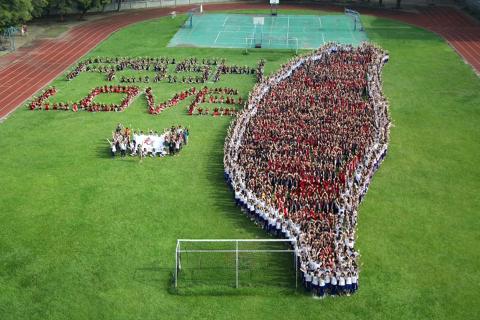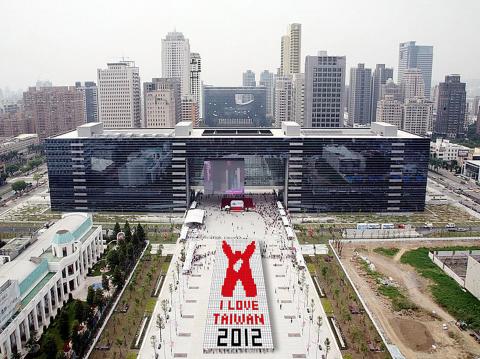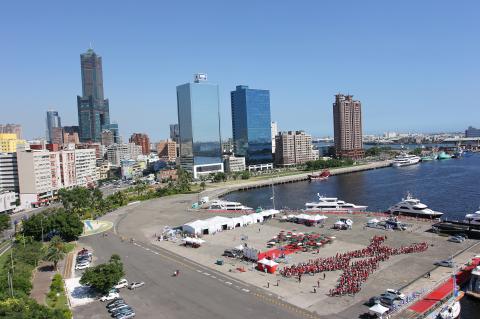If you’re driving down Taiwan Boulevard (臺灣大道) in Taichung on Oct. 10, you just might see the words “I Love Taiwan” displayed across a 20m by 50m mosaic. And, the 2,012 people supporting this proclamation hope to make history by forming the world’s largest picture mosaic.
Shaun Bettinson, the organizer, hopes the event held at Taichung City Hall will shatter the current two-year-old Guinness World Record, when 1,458 people formed a picture mosaic in the US.
“I have a lot of passion for this,” Bettinson said.

Photo Courtesy of Shaun Bettinson
So, it seems, do others. He’s enlisted the aid of nearly 230 volunteers for the day to register participants and give out T-shirts, stickers and balloons adorned with the slogan, “I Love Taiwan.”
Bettinson, an affable 32-year-old native of England who has called Taichung home for the last eight years, garnered recent media attention with a Facebook campaign that gathered thousands of photos of people with their arms jutting into the air as a sign of their love for Taiwan.
Participants were not only asked to submit a picture, but also to explain why they love Taiwan and state how the country can be improved.

Photo Courtesy of Shaun Bettinson
Bigger picture
Showing your love for Taiwan is as simple as taking a picture, he said. “You can take a lot from Taiwan. But this is about giving something back that’s bigger than yourself.”
The Taichung City Government is throwing its weight behind the project. The city will provide tents, water, tables and chairs for the Oct. 10 event, which will coincide with festivities celebrating the Republic of China’s (ROC) Double Ten National Day.

Photo Courtesy of Shaun Bettinson
Double Ten (雙十節), as it’s commonly known in Mandarin, celebrates the start of the Wuchang Uprising on Oct. 10, 1911, which led to the collapse of the Qing Dynasty and the founding of the ROC in 1912.
“Shaun is really great and really sweet,” said Huang Shao-fu (黃少甫), the chief of the city’s Marketing and Planning Division. “He’s bringing people together to show that everyone loves Taiwan.”
Huang said that Taichung Mayor Jason Hu (胡志強) believes the outpouring of emotion for the country is amazing, especially since it’s spearheaded by a non-Taiwanese. Only during election day or national day do you usually hear people declaring their love for their country, Huang added.
Bettinson said that while he welcomes the government’s help, the “I Love Taiwan” campaign has no political agenda.
Giving back
“This is just a way to say thank you,” he said. To Bettinson’s joy, throngs of others have also been empowered with national pride.
One photo shows 2,500 high school students in Kaohsiung standing in the shape of Taiwan, while raising their arms declaring their love for the country. In another, a baby’s arms are thrust into the air forming a “V” sign. Photographic backdrops throughout the island have varied from skyscrapers to mountaintops.
“It’s amazing how the whole community has come together,” said Patrick Byrne, an 11-year resident of Taichung.
Like many expats living in Taiwan, Byrne has his own story to tell of Taiwanese generosity — which seems to have rubbed off on Bettinson.
Byrnes’ son, Fionn, was born prematurely and needed medical care totaling NT$1.2 million. Without health insurance the bills seemed insurmountable, but Bettinson organized several charity events that raised enough funds to cut the bills nearly in half.
“He’s an amazing friend. We couldn’t have done it without him,” Byrne said.
The original idea for the “I Love Taiwan” photo campaign came in April with a Facebook appeal for photos. Within a half hour, he had his first photo. Five months later he’s collected more than 35,000 photos and his initial YouTube video has been viewed upwards of 500,000 times.
At first, Bettinson planned to showcase a stockpile of 201,210 photos in a massive collage on the side of Taipei 101 for Double Ten, but the NT$10 million cost proved prohibitive.
Despite the setback, Bettinson continues to amass a collection of photos, and is considering other venues to display the collage. “I’m just going to keep going and get as many pictures as possible.”
Breaking a record
In the meantime, Bettinson is focused on gathering together as many people as possible for the Oct. 10 event so as to break the world record. While he doesn’t expect Guinness representatives to be present, he is hoping video, photos and witnesses will validate that the 2,012-person mosaic is indeed a world record.
One of those who will be helping out is Taichung resident Pay Liu (劉權霈), who saw Bettinson’s online photo appeal and was determined to get involved. Liu was able to help bring in sponsors who will be supplying promotional balloons and stickers.
“This is a meaningful event,” he said. “People should get involved.”

That US assistance was a model for Taiwan’s spectacular development success was early recognized by policymakers and analysts. In a report to the US Congress for the fiscal year 1962, former President John F. Kennedy noted Taiwan’s “rapid economic growth,” was “producing a substantial net gain in living.” Kennedy had a stake in Taiwan’s achievements and the US’ official development assistance (ODA) in general: In September 1961, his entreaty to make the 1960s a “decade of development,” and an accompanying proposal for dedicated legislation to this end, had been formalized by congressional passage of the Foreign Assistance Act. Two

March 31 to April 6 On May 13, 1950, National Taiwan University Hospital otolaryngologist Su You-peng (蘇友鵬) was summoned to the director’s office. He thought someone had complained about him practicing the violin at night, but when he entered the room, he knew something was terribly wrong. He saw several burly men who appeared to be government secret agents, and three other resident doctors: internist Hsu Chiang (許強), dermatologist Hu Pao-chen (胡寶珍) and ophthalmologist Hu Hsin-lin (胡鑫麟). They were handcuffed, herded onto two jeeps and taken to the Secrecy Bureau (保密局) for questioning. Su was still in his doctor’s robes at

Last week the Democratic Progressive Party (DPP) said that the budget cuts voted for by the China-aligned parties in the legislature, are intended to force the DPP to hike electricity rates. The public would then blame it for the rate hike. It’s fairly clear that the first part of that is correct. Slashing the budget of state-run Taiwan Power Co (Taipower, 台電) is a move intended to cause discontent with the DPP when electricity rates go up. Taipower’s debt, NT$422.9 billion (US$12.78 billion), is one of the numerous permanent crises created by the nation’s construction-industrial state and the developmentalist mentality it

Experts say that the devastating earthquake in Myanmar on Friday was likely the strongest to hit the country in decades, with disaster modeling suggesting thousands could be dead. Automatic assessments from the US Geological Survey (USGS) said the shallow 7.7-magnitude quake northwest of the central Myanmar city of Sagaing triggered a red alert for shaking-related fatalities and economic losses. “High casualties and extensive damage are probable and the disaster is likely widespread,” it said, locating the epicentre near the central Myanmar city of Mandalay, home to more than a million people. Myanmar’s ruling junta said on Saturday morning that the number killed had